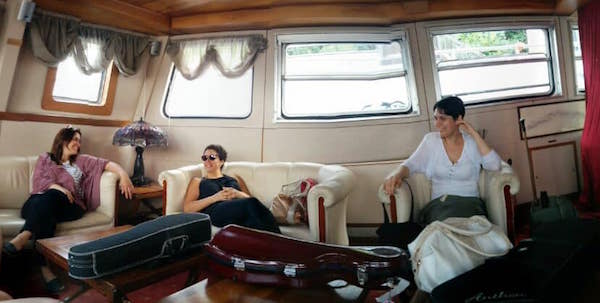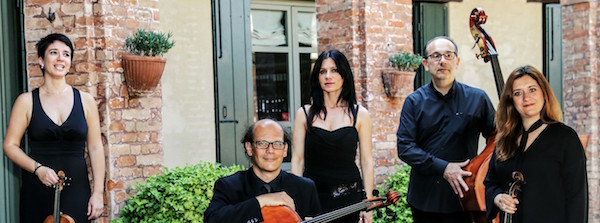 We speak already English!
We speak already English!
Ancient instruments, modern visions
Il Tetraone was born within an ideal "great quartet" like the Accademia Bizantina, combining its philosophy and closing a perfect circle in the most genuinely chamber music form. What strikes this group is the clear adherence to aesthetic concepts matured in years of study and common work in our Orchestra, combined with a personality and a communicative nature surprising. Qualities and emotions that seduce. | OTTAVIO DANTONE
Il Tetraone is a piano quartet formed in 2011 within Accademia Bizantina. The aim is to combine friendship and the joy of playing together of each musician, deepening one of the most interesting repertoire that the history of music offers. Il Tetraone, naturally, performs on historical instruments, with a particular care to instrument’s fittings, tuning and temperamentreferred to the historical period. Using these means, together with a filological approach to the score, the care of sound, the research of timbre and trasparence, the group is able to propose a new lecture and interpretation of this great repertoire. The piano quartet expands and evolves with the addition of Giovanni Valgimigli, contrabass player from Accademia Bizantina, to explore the repertoire of piano quintet with contrabass, whose most famous masterpiece is certainly “The Trout” by Franz Schubert, but that reserves many other surprises, less well known by the audience, so fully beautiful and interesting.
Il Tetraone, since its foundation, has made use of the collaboration of Francesco Zanotto and his collection of keyboard instruments from which he chooses, for each program, the philologically appropriate instrument.
In December 2019 the first CD of "Il Tetraone" was released by Novantiqua, with L.V. Beethoven's Quartet op.16 and Schubert's "La Trota" Quintet, which received flattering consents and appreciation.
→ www.IlTetraone.com

An original sound. An unstoppable temper.
The debut recording of Il Tetraone. An interpretation on original instruments that struggles to find its equals in the current landscape. A prodigy of technique and temperament at the service of an enormous work of in-depth analysis on the instruments and executive practices.
When Schubert saw the light in 1797 in Lichtental, a suburb now incorporated into the metropolitan area of Vienna, Beethoven was a young prodigy of 27 years, sensitive to the conventions of the Viennese society of the time and very attached to the classical models of Haydn and Mozart.
The Quartet op. 16 contains the essence of the style of the first Beethoven revealing a serenity without clouds in his frank and open cantabilità as an expression of an extroverted youthful optimism.
In the summer of 1819 Franz Schubert was 22 years old and was on holiday in Steyr, a small village in Upper Austria, together with his baritone friend Johann Michael Vogl, his fellow adventurer in what was also his first liederistic tour away from Vienna. It was undoubtedly one of the most serene and relaxing moments of his life, surrounded by a wonderful place - as he said in a letter to his brother -, surrounded by nature and the scent of pine trees and mountains. He stayed at Dr. Schellmann’s house, where the music was at home. The Quintet for piano, violin, viola, cello and double bass op. 114 D 667 «Forellen-quintett», composed in the autumn of 1819 and published after the death of the composer by the publisher Joseph Czerny, who said he had decided to do it after a group of experts that he gathered for the occasion had unanimously recognized him «a masterpiece».
→ www.iltetraone.com|Schubert-Beethoven

The romantic sound on period instruments
Robert Schumann, Piano Quartet op.47
Louise Farrenc, Piano Quintet nr.1 op.30
A program that combines two composers united by the sad fate of an unhappy life and studded with suffering and grief. But the choice of these two masterpieces full of enthusiasm, vitality and joy wants to make the listener live the creative forces of the two musical genies. Schumann’s famous quartet is combined with the splendid composition by Farrenc that, with the same ensemble of Schubert’s Forellenquintett, surprises us with its original and profound language.
→ www.iltetraone.com|Schumann-Farrenc

Two masterpieces, two persanalities, two worlds
Among the chamber music ensembles, the one for piano and strings (violin, viola and cello) is not among the most frequent in Mozart’s time, when the piano was mostly combined with the orchestra in the Concerto genre, and the strings were arranged in homogeneous formations, like the Quartet and the Quintet. In the autumn of 1785, in the fifth year of his career as a freelancer, Mozart, a volcano in perpetual eruption, which invested the market with gigantic flows of music, wrote the Quartetto K478, probably thought not as an oasis of the spirit, but as a source of income, as a novelty that would have intrigued the whimsical Viennese. The K 493 Quartet, in E flat major, has a more serene character and comes even closer to the writing of concerts than the chamber music.
For this programm the Collezione Zanotto provides a Viennese Graf fortepiano
→ www.iltetraone.com|Mozart
Clicca sull'immagine desiderata per scaricarla in alta risoluzione